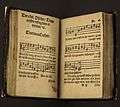Geh aus, mein Herz, und suche Freud
| Geh aus, mein Herz, und suche Freud | |
|---|---|
| Hymn by Paul Gerhardt | |
_1.jpg) A three-part setting in a hymnal of the Lutheran congregations in Philadelphia, 1876 | |
| English | Go Forth, My Heart and Seek Delight |
| Text | by Paul Gerhardt |
| Language | German |
| Published | 1653 |
"Geh aus, mein Herz, und suche Freud" ("Go Forth, My Heart, and Seek Delight") is a summer hymn with a text by Paul Gerhardt written in 1653.
It was first published that same year in the fifth edition of Johann Crüger's hymnal Praxis Pietatis Melica. It was sung to several melodies, the most popular one having been composed by August Harder, and became a Volkslied (folk song) in an abridged version.
It was rendered into several English-language versions. A Swedish version became a popular graduation song.
Text
Gerhardt wrote his poem in 1653, five years after the end of the Thirty Years' War.
The text of originally fifteen stanzas of six lines, each, begins with admiration of God's creation, observed in gardens and in nature. The second part, beginning with stanza 9, reflects paradise as an even greater garden.
The final two stanzas contain prayers: "... dass ich dir werd ein guter Baum" ("... that I become a good tree for you"); "Verleihe, daß zu deinem Ruhm ich deines Gartens schöne Blum und Pflanze möge bleiben" ("Grant that I may remain a beautiful flower and plant of your garden"); and "laß mich bis zur letzten Reis an Leib und Seele grünen" ("let me be green in body and soul until the final journey").[1]
The song was first published the same year (1653) in the fifth edition of Johann Crüger's hymnal Praxis Pietatis Melica.[2]
Many publications contain only stanzas 1 to 3 and 8. In the abridged version, the hymn became a Volkslied (folk song).
Melodies and music
When the song was first published, it was sung to the melody of "Den Herrn meine Seel erhebt".[2] In 1667 Johann Georg Ebeling composed a new melody, published in the collection, Pauli Gerhardi Geistliche Andachten (Sacred Contemplations of Paul Gerhardt).[3] In the collection, which was intended for church and home, the melody appeared in the soprano of a four-part setting with two instrumental parts ad libitum.
The ![]() most popular melody was composed by August Harder.[4] It was originally intended for the poem "Die Luft ist blau, das Tal ist grün" by Ludwig Hölty. The organist Friedrich Eickhoff applied it to Gerhardt's song first in 1836. The hymn appears with this melody in the current Protestant hymnal, Evangelisches Gesangbuch, as number 503.
most popular melody was composed by August Harder.[4] It was originally intended for the poem "Die Luft ist blau, das Tal ist grün" by Ludwig Hölty. The organist Friedrich Eickhoff applied it to Gerhardt's song first in 1836. The hymn appears with this melody in the current Protestant hymnal, Evangelisches Gesangbuch, as number 503.
In the 1920s Walther Hensel wrote yet another melody which appeared in the then popular collection, Bruder Singer.
Rudolf Mauersberger composed a sacred summer music (Geistliche Sommermusik) Geh aus, mein Herz, und suche Freud (Mauersberger) (RMWV 11).
Translations
Among several versions, Catherine Winkworth translated it as "Go Forth, My Heart, and Seek Delight".[5][6]
In Sweden, as "I denna ljuva sommartid", it has become a popular graduation song together with "Den blomstertid nu kommer".[7]
References
| Wikimedia Commons has media related to Geh aus, mein Herz, und suche Freud. |
- ↑ Heike Springhart: Dr. Heike Springhart über EG 503 (Geh aus, mein Herz...) University of Heidelberg 14 August 2011, accessdate: 15 January 2015
- 1 2 Johann Crüger, Praxis Pietatis Melica. Das ist: Übung der Gottseligkeit in Christlichen und trostreichen Gesängen, Berlin, Editio V. Runge, 1653, p. 779 ff. (Digitalisat of the Bayerische Staatsbibliothek).
- ↑ Friedhelm Kemp (Hrsg.): Paul Gerhardt. Geistliche Andachten. Reprinted: Bern, 1975.
- ↑ Matthias Werner: Harder, August. In: Wolfgang Herbst, Wer ist wer im Gesangbuch? Göttingen, Vandenhoeck & Ruprecht, 2001, ISBN 3-525-50323-7, p. 131 f. (, p. 131, at Google Books).
- ↑ Siemon-Netto, Uwe: "Entrust Your Days and Burdens" Paul Gerhardt's 17th-century hymns still enthrall the world The Atlantic Times, March 2007, accessdate: 15 January 2015
- ↑ Geh aus, mein Herz, und suche Freud hymnary.org, accessdate: 15 January 2015
- ↑ Södermanlands nyheter 10 June 2011 - Skolavslutning i kyrkan, accessdate: 3 August 2014
External links
- Geh aus, mein Herz, und suche Freud: Scores at the International Music Score Library Project
- Steiger, Johann Anselm: "Geh' aus, mein Herz, und suche Freud" / Paul Gerhardts Sommerlied und die Gelehrsamkeit der Barockzeit (Naturkunde, Emblematik, Theologie) / (Paul Gerhardt's Summer Song and the Erudition of the Baroque) De Gruyter
- Geh aus, mein Herz, und suche Freud text and interpretation on deutschelieder.wordpress.com (German)
- Geh aus, mein Herz, und suche Freud text and Harder melody in lieder-archiv.de
- Geh aus, mein Herz, und suche Freud text in liederdatenbank.de
